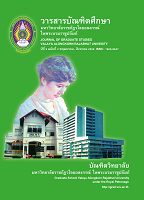การพัฒนาผลสัมฤทธิ์ทางการเรียนศิลปะโดยใช้สื่อประสมสำหรับนักเรียนชั้นประถมศึกษาปีที่ 5
Main Article Content
Abstract
การวิจัยในครั้งนี้มีวัตถุประสงค์ 1) เพื่อพัฒนาสื่อประสมเรื่องการสร้างสรรค์งานพิมพ์ภาพ 2) เพื่อพัฒนาผลสัมฤทธิ์ทางการเรียนศิลปะของนักเรียนที่ได้รับการสอนด้วยสื่อประสม ก่อนเรียน ระหว่างเรียน และหลังเรียน และ 3) เพื่อศึกษาความพึงพอใจของนักเรียนที่มีต่อวิธีสอนโดยใช้สื่อประสม กลุ่มตัวอย่างที่ใช้ในการศึกษาครั้งนี้ เป็นนักเรียนชั้นประถมศึกษาปีที่ 5 โรงเรียนเทศบาล 2 (วัดศรีบุรีรตนาราม) อำเภอเมือง จังหวัดสระบุรี ที่กำลังศึกษาอยู่ในภาคเรียนที่ 1 ปีการศึกษา 2556 จำนวน 2 ห้องเรียน จำนวนนักเรียน 60 คน ซึ่งได้มาโดยใช้วิธีการสุ่มแบบกลุ่ม (Cluster sampling) และใช้การสุ่มอย่างง่ายเพื่อให้กลุ่มหนึ่งเป็นกลุ่มทดลองจัดการเรียนรู้โดยใช้สื่อประสม อีกกลุ่มหนึ่งเป็นกลุ่มควบคุมสอนโดยวิธีปกติ เครื่องมือที่ใช้ในการวิจัยครั้งนี้ประกอบด้วย 1) แผนการจัดการเรียนรู้ศิลปะ จำวน 8 แผนๆ ละ 1 ชั่วโมง 2) สื่อประสมประกอบด้วยบทเรียนคอมพิวเตอร์ช่วยสอน และรูปภาพ เรื่องการสร้างสรรค์งานพิมพ์ภาพ จำวน 8 เรื่อง 3) แบบทดสอบวัดผลสัมฤทธิ์ทางการเรียนศิลปะชนิด 4 ตัวเลือก 30 ข้อ ที่มีความเชื่อมั่นเท่ากับ 0.993 ค่าอำนาจจำแนกระหว่าง 0.30 – 0.50 และค่าความยากระหว่าง 0.53 – 0.73 4) แบบวัดความพึงพอใจของนักเรียนที่มีต่อวิธีสอนโดยใช้สื่อประสมแบบมาตรส่วนประเมินค่า 5 ระดับ 5) แบบประเมินคุณภาพของสื่อประสม สถิติพรรณนาที่ใช้ในการวิเคราะห์ข้อมูลคือ ค่าเฉลี่ย ค่าร้อยละ ค่าส่วนเบี่ยงเบนมาตรฐาน และสถิติที่ใช้ทดสอบสมมุติฐานความแตกต่าง ค่าเฉลี่ยของคะแนนจากแบบทดสอบวัดผลสัมฤทธิ์ทางการเรียนโดยใช้สื่อประสม ซึ่งใช้การวิเคราะห์ความแปรปรวนสองทางแบบวัดซ้ำ (Repeated measure two ways ANOVA)
ผลการศึกษาวิจัยพบว่า
1) สื่อประสมเรื่องการสร้างสรรค์งานพิมพ์ภาพ ที่พัฒนาขึ้นมีประสิทธิภาพ 81.17/84.78 ซึ่งเป็นไปตามเกณฑ์ที่กำหนด 80/80
2) ผลสัมฤทธิ์ทางการเรียนของนักเรียนที่เรียนด้วยสื่อประสมสูงกว่าผลสัมฤทธิ์ทางการเรียนของนักเรียนที่ไม่ได้เรียนด้วยสื่อประสม และมีพัฒนาการของผลสัมฤทธิ์เป็นไปในทางที่เพิ่มขึ้นตามลำดับขั้นของการทดลอง
3) ความพึงพอใจของนักเรียนที่มีต่อวิธีสอนโดยใช้สื่อประสม หลังการเรียนด้วยสื่อประสมอยู่ในระดับพึงพอใจมากที่สุด
The purposes of the research were : 1) to develop the inventive printing subject multimedia, 2) to study the development of student learning achievement in arts before, between and after learning by using the inventive printing multimedia, 3) to study the satisfaction of student by using multimedia teaching methods.The samples in this study were Prathomsuksa 5 student in the first semester of the academic year 2013 in Tassaban 2 School (Watsribureeratanaram), Maung District, Saraburi Province, consisting of 2 classes of 60 students obtained by cluster random sampling. By using simple random sampling, the subject were divided into experimental and control group. The instruments used in the study were: 1) the learning plan in arts consisting of 8 plans and 8 period, 2) the inventive printing subject multimedia with computer assisted instruction and picture, and 3) the learning achievement test in arts with 4 multiple choices, the alpha coefficient equals to 0.993, the discrimination value between 0.30 – 0.50 and difficulty value between 0.53 – 0.73, 4) the five - point rating scale of the student satisfaction by using multimedia teaching methods, and 5) the qualitative evaluaion form for multimedia. The statistics used for analysis were mean, standard deviation, percentage, and repeated measure two–ways ANOVA.
The results were as follows:
1) The efficiency of the inventive printing subject multimedia was 81.17/84.78 which met the determined criteria of 80/80.
2) The learning achievement of the students learned by using the inventive printing subject multimedia was higher than those who did not and the development
of the students achievement was increased throughout the experiment.
3) The satisfaction of student with multimedia teaching methods after learning was at the highest.
Article Details
บทความทุกเรื่องได้รับการตรวจความถูกต้องทางวิชาการโดยผู้ทรงคุณวุฒิ ทรรศนะและข้อคิดเห็นในบทความวารสารบัณฑิตศึกษา มหาวิทยาลัยราชภัฏวไลยอลงกรณ์ ในพระบรมราชูปถัมภ์ มิใช่เป็นทรรศนะและความคิดของผู้จัดทำจึงมิใช่ความรับผิดชอบของบัณฑิตวิทยาลัย มหาวิทยาลัยราชภัฏวไลยอลงกรณ์ ในพระบรมราชูปถัมภ์ กองบรรณาธิการไม่สงวนสิทธิ์การคัดลอก แต่ให้อ้างอิงแหล่งที่มา


